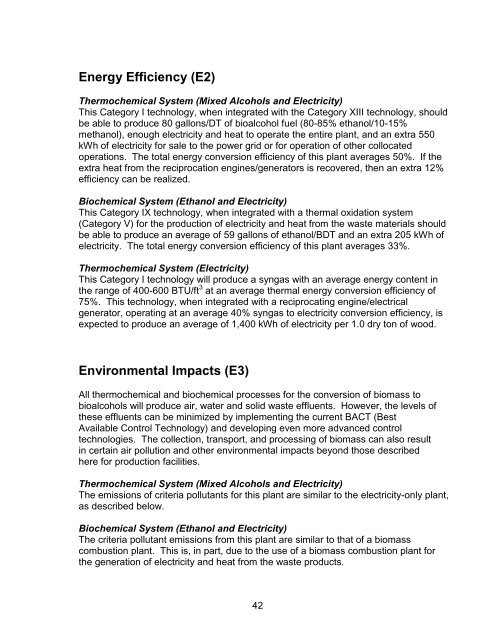Assessment of Conversion Technologies for Bioalcohol Fuel ...
Assessment of Conversion Technologies for Bioalcohol Fuel ...
Assessment of Conversion Technologies for Bioalcohol Fuel ...
You also want an ePaper? Increase the reach of your titles
YUMPU automatically turns print PDFs into web optimized ePapers that Google loves.
Energy Efficiency (E2)<br />
Thermochemical System (Mixed Alcohols and Electricity)<br />
This Category I technology, when integrated with the Category XIII technology, should<br />
be able to produce 80 gallons/DT <strong>of</strong> bioalcohol fuel (80-85% ethanol/10-15%<br />
methanol), enough electricity and heat to operate the entire plant, and an extra 550<br />
kWh <strong>of</strong> electricity <strong>for</strong> sale to the power grid or <strong>for</strong> operation <strong>of</strong> other collocated<br />
operations. The total energy conversion efficiency <strong>of</strong> this plant averages 50%. If the<br />
extra heat from the reciprocation engines/generators is recovered, then an extra 12%<br />
efficiency can be realized.<br />
Biochemical System (Ethanol and Electricity)<br />
This Category IX technology, when integrated with a thermal oxidation system<br />
(Category V) <strong>for</strong> the production <strong>of</strong> electricity and heat from the waste materials should<br />
be able to produce an average <strong>of</strong> 59 gallons <strong>of</strong> ethanol/BDT and an extra 205 kWh <strong>of</strong><br />
electricity. The total energy conversion efficiency <strong>of</strong> this plant averages 33%.<br />
Thermochemical System (Electricity)<br />
This Category I technology will produce a syngas with an average energy content in<br />
the range <strong>of</strong> 400-600 BTU/ft 3 at an average thermal energy conversion efficiency <strong>of</strong><br />
75%. This technology, when integrated with a reciprocating engine/electrical<br />
generator, operating at an average 40% syngas to electricity conversion efficiency, is<br />
expected to produce an average <strong>of</strong> 1,400 kWh <strong>of</strong> electricity per 1.0 dry ton <strong>of</strong> wood.<br />
Environmental Impacts (E3)<br />
All thermochemical and biochemical processes <strong>for</strong> the conversion <strong>of</strong> biomass to<br />
bioalcohols will produce air, water and solid waste effluents. However, the levels <strong>of</strong><br />
these effluents can be minimized by implementing the current BACT (Best<br />
Available Control Technology) and developing even more advanced control<br />
technologies. The collection, transport, and processing <strong>of</strong> biomass can also result<br />
in certain air pollution and other environmental impacts beyond those described<br />
here <strong>for</strong> production facilities.<br />
Thermochemical System (Mixed Alcohols and Electricity)<br />
The emissions <strong>of</strong> criteria pollutants <strong>for</strong> this plant are similar to the electricity-only plant,<br />
as described below.<br />
Biochemical System (Ethanol and Electricity)<br />
The criteria pollutant emissions from this plant are similar to that <strong>of</strong> a biomass<br />
combustion plant. This is, in part, due to the use <strong>of</strong> a biomass combustion plant <strong>for</strong><br />
the generation <strong>of</strong> electricity and heat from the waste products.<br />
42
















